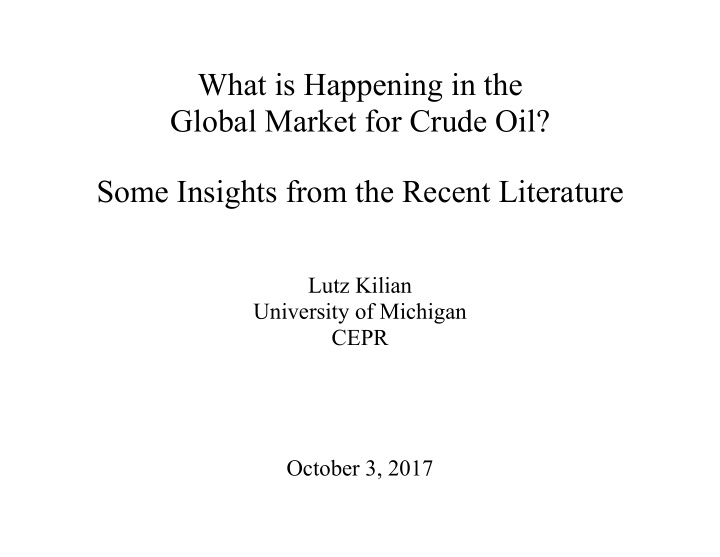



What is Happening in the Global Market for Crude Oil? Some Insights from the Recent Literature Lutz Kilian University of Michigan CEPR October 3, 2017
Modeling the Global Price of Oil 1. Oil is an industrial commodity much like copper, iron ore, or scrap metal. 2. Its price is determined by the forces of demand and supply. 3. There was no global market for crude oil prior to 1974 and no global price. Moreover, the price of crude oil was regulated. Empirical analysis of the global oil market must be restricted to data since 1974.
Real Price of WTI Crude Oil, 1974.1-2017.8 2017.8 Dollars
What We Have Learned in Recent Years 1. In the 1980s, the presumption was that oil supply shocks are the main determinant of oil price fluctuations. We now understand that most historical oil price fluctuations have been driven by shifts in the demand for oil associated with the global business cycle. 2. OPEC has never had much influence over the price of oil. 3. Oil supply disruptions associated with political events in the Middle East have little explanatory power for the global price of oil. 4. Middle Eastern political events in conjunction with a booming global economy, however, may fuel storage demand for oil by raising oil price expectations.
Structural Model of the Global Oil Market ● Structural vector autoregressive model of the global market for crude oil (see, e.g., Kilian and Murphy, JAE 2014): (1) growth in global crude oil production ; (2) measure of cyclical variation in global real economic activity ; (3) the real price of crude oil ; (4) change in above-ground global crude oil inventories. ● Estimation on data for 1973.2-2015.8 with seasonal dummies and 24 monthly lags. ● The model differentiates between flow supply shocks, flow demand shocks, shocks to storage demand driven by shifts in oil price expectations (and a residual shock designed to capture idiosyncratic changes in SPR and shifts in storage technology and preferences).
1. Identifying Restrictions on Sign of Impact Responses Flow Supply Flow Demand Storage Shock Shock Demand Shock Oil Production - + + Real Activity - + - Real Oil Price + + + Inventories +
2. Bound on One-Month Price Elasticity of Supply Consensus: The impact price elasticity of oil supply is near zero. ● Why? Anecdotal evidence: Kilian (AER 2009) Economic theory: Anderson, Kellogg and Salant (JPE 2017) Microeconomic estimates in literature: 0.009 ● Oil supply elasticity bound: 0.025 (baseline) Oil Supply
3. Bound on One-Month Price Elasticity of Demand ● Standard demand elasticity measures equate the production of oil with the consumption of oil and ignore the role of inventory changes. ● We restrict the impact price elasticity of oil demand in use , which accounts for changes in inventories, to be smaller in absolute terms than extraneous micro - estimates of long-run elasticity (Hausman and Newey, Ecta 1995): 0.8 0 Oil Use
Model Estimation and Evaluation ● Simulate the posterior of the model by standard methods. ● Recover unique estimates of the structural impulse responses as in Kilian and Lee (JIMF 2014) by selecting the admissible structural model with the short-run price elasticity of oil demand closest to the benchmark estimate of -0.26 in the literature (see Kilian and Murphy, JAE 2014; Coglianese et al., JAE 2017).
Oil production Oil production Oil production Source: Kilian (EnJ 2017). Responses to Oil Demand and Oil Supply Shocks Real activity Real activity Real activity Real price of oil Real price of oil Real price of oil Inventories Inventories Inventories
Determinants of Oil Price Fluctuations, 2002.6-2015.8 Cumulative Effect of Flow Supply Shock on Real Price of Crude Oil 100 0 -100 2004 2006 2008 2010 2012 2014 Cumulative Effect of Flow Demand Shock on Real Price of Crude Oil 100 0 -100 2004 2006 2008 2010 2012 2014 Cumulative Effect of Storage Demand Shock on Real Price of Crude Oil 100 0 -100 2004 2006 2008 2010 2012 2014 Source: Kilian (EnJ 2017).
What Caused the Oil Price Decline after June 2014? Log Log Log
The Impact of U.S. Shale Oil Production on the Brent Price 140 120 100 80 60 40 20 0 2009 2010 2011 2012 2013 2014 2015 Source: Kilian (EnJ 2017)
Has the Global Oil Market Changed since 2014? ● In what sense is Saudi Arabia a swing producer? Responses to geopolitical oil supply disruptions vs. responses to the global business cycle ● Should Saudi Arabia have cut oil production? ○ Can Saudi Arabia control its oil revenue? ○ Long memories of the early1980s ○ How much market power with 10% market share? ○ Where were the Saudis in 1998? ● Is shale oil the new “swing producer” that stabilizes the price? ○ Two years ' lead time for new production is long . ○ Can shale oil production rise much above 4% of market `` share? ○ How much oil is left? Further technological advances?
Where do we expect the price of oil to go from here? 1. How resilient are U.S. and Canadian oil producers? 2. How about state-controlled oil producers (Russia, Iran, Iraq)? 3. What are the constraints on the investment of state-controlled oil producers (e.g., Exxon/Rosneft)? 4. What are the effects of worldwide cutbacks on exploration? 5. How soon will oil production elsewhere run out or remain disrupted (e.g., Nigeria, Venezuela, Mexico, Norway, UK)? 6. Coordinated supply cuts (Russia, OPEC) unsustainable. 7. How soon will the global economy recover? Electric cars? 8. If the Middle Eastern oil producers do not manage the transition well, the geopolitical risk in the Middle East is likely to increase sharply, which in turn would raise the price of oil. Expect a gradual price recovery in perhaps two years
Financial Market Expectations of the Brent Oil Price Dollars Source: Baumeister and Kilian (2017) Evidence of mean reversion in price expectations after June 2014. As of July 2017, markets expected the Brent price to rise to $61 by July 2018.
Recommend
More recommend